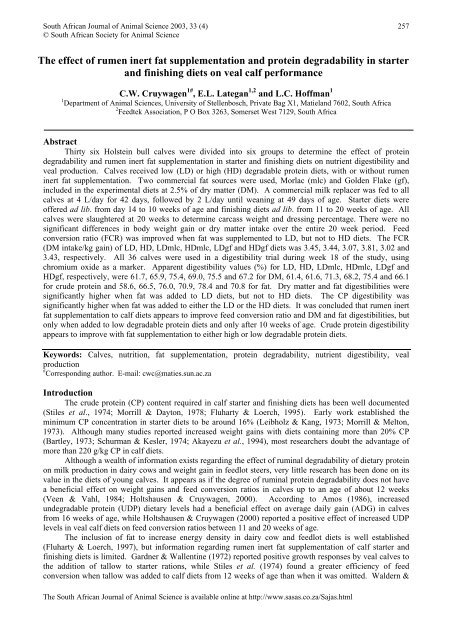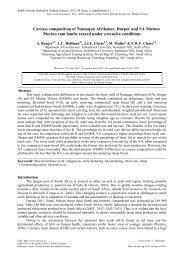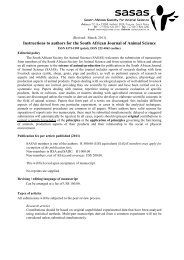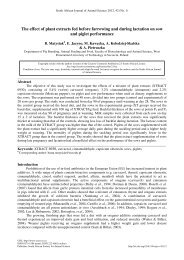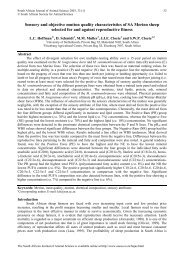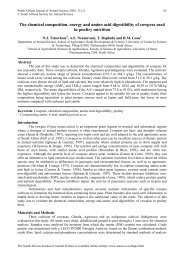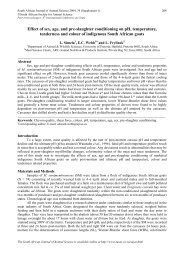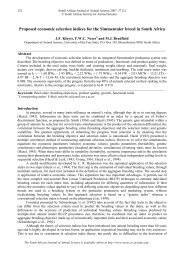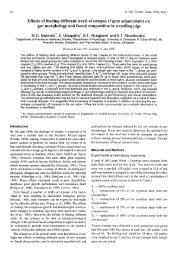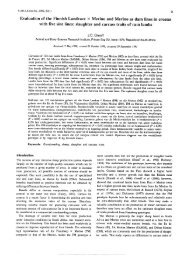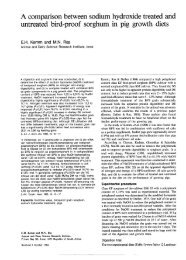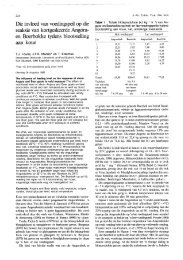The effect of rumen inert fat supplementation and protein - African ...
The effect of rumen inert fat supplementation and protein - African ...
The effect of rumen inert fat supplementation and protein - African ...
You also want an ePaper? Increase the reach of your titles
YUMPU automatically turns print PDFs into web optimized ePapers that Google loves.
South <strong>African</strong> Journal <strong>of</strong> Animal Science 2003, 33 (4)© South <strong>African</strong> Society for Animal Science257<strong>The</strong> <strong>effect</strong> <strong>of</strong> <strong>rumen</strong> <strong>inert</strong> <strong>fat</strong> <strong>supplementation</strong> <strong>and</strong> <strong>protein</strong> degradability in starter<strong>and</strong> finishing diets on veal calf performanceC.W. Cruywagen 1# , E.L. Lategan 1,2 <strong>and</strong> L.C. H<strong>of</strong>fman 11 Department <strong>of</strong> Animal Sciences, University <strong>of</strong> Stellenbosch, Private Bag X1, Matiel<strong>and</strong> 7602, South Africa2 Feedtek Association, P O Box 3263, Somerset West 7129, South AfricaAbstractThirty six Holstein bull calves were divided into six groups to determine the <strong>effect</strong> <strong>of</strong> <strong>protein</strong>degradability <strong>and</strong> <strong>rumen</strong> <strong>inert</strong> <strong>fat</strong> <strong>supplementation</strong> in starter <strong>and</strong> finishing diets on nutrient digestibility <strong>and</strong>veal production. Calves received low (LD) or high (HD) degradable <strong>protein</strong> diets, with or without <strong>rumen</strong><strong>inert</strong> <strong>fat</strong> <strong>supplementation</strong>. Two commercial <strong>fat</strong> sources were used, Morlac (mlc) <strong>and</strong> Golden Flake (gf),included in the experimental diets at 2.5% <strong>of</strong> dry matter (DM). A commercial milk replacer was fed to allcalves at 4 L/day for 42 days, followed by 2 L/day until weaning at 49 days <strong>of</strong> age. Starter diets were<strong>of</strong>fered ad lib. from day 14 to 10 weeks <strong>of</strong> age <strong>and</strong> finishing diets ad lib. from 11 to 20 weeks <strong>of</strong> age. Allcalves were slaughtered at 20 weeks to determine carcass weight <strong>and</strong> dressing percentage. <strong>The</strong>re were nosignificant differences in body weight gain or dry matter intake over the entire 20 week period. Feedconversion ratio (FCR) was improved when <strong>fat</strong> was supplemented to LD, but not to HD diets. <strong>The</strong> FCR(DM intake/kg gain) <strong>of</strong> LD, HD, LDmlc, HDmlc, LDgf <strong>and</strong> HDgf diets was 3.45, 3.44, 3.07, 3.81, 3.02 <strong>and</strong>3.43, respectively. All 36 calves were used in a digestibility trial during week 18 <strong>of</strong> the study, usingchromium oxide as a marker. Apparent digestibility values (%) for LD, HD, LDmlc, HDmlc, LDgf <strong>and</strong>HDgf, respectively, were 61.7, 65.9, 75.4, 69.0, 75.5 <strong>and</strong> 67.2 for DM, 61.4, 61.6, 71.3, 68.2, 75.4 <strong>and</strong> 66.1for crude <strong>protein</strong> <strong>and</strong> 58.6, 66.5, 76.0, 70.9, 78.4 <strong>and</strong> 70.8 for <strong>fat</strong>. Dry matter <strong>and</strong> <strong>fat</strong> digestibilities weresignificantly higher when <strong>fat</strong> was added to LD diets, but not to HD diets. <strong>The</strong> CP digestibility wassignificantly higher when <strong>fat</strong> was added to either the LD or the HD diets. It was concluded that <strong>rumen</strong> <strong>inert</strong><strong>fat</strong> <strong>supplementation</strong> to calf diets appears to improve feed conversion ratio <strong>and</strong> DM <strong>and</strong> <strong>fat</strong> digestibilities, butonly when added to low degradable <strong>protein</strong> diets <strong>and</strong> only after 10 weeks <strong>of</strong> age. Crude <strong>protein</strong> digestibilityappears to improve with <strong>fat</strong> <strong>supplementation</strong> to either high or low degradable <strong>protein</strong> diets.Keywords: Calves, nutrition, <strong>fat</strong> <strong>supplementation</strong>, <strong>protein</strong> degradability, nutrient digestibility, vealproduction# Corresponding author. E-mail: cwc@maties.sun.ac.zaIntroduction<strong>The</strong> crude <strong>protein</strong> (CP) content required in calf starter <strong>and</strong> finishing diets has been well documented(Stiles et al., 1974; Morrill & Dayton, 1978; Fluharty & Loerch, 1995). Early work established theminimum CP concentration in starter diets to be around 16% (Leibholz & Kang, 1973; Morrill & Melton,1973). Although many studies reported increased weight gains with diets containing more than 20% CP(Bartley, 1973; Schurman & Kesler, 1974; Akayezu et al., 1994), most researchers doubt the advantage <strong>of</strong>more than 220 g/kg CP in calf diets.Although a wealth <strong>of</strong> information exists regarding the <strong>effect</strong> <strong>of</strong> ruminal degradability <strong>of</strong> dietary <strong>protein</strong>on milk production in dairy cows <strong>and</strong> weight gain in feedlot steers, very little research has been done on itsvalue in the diets <strong>of</strong> young calves. It appears as if the degree <strong>of</strong> ruminal <strong>protein</strong> degradability does not havea beneficial <strong>effect</strong> on weight gains <strong>and</strong> feed conversion ratios in calves up to an age <strong>of</strong> about 12 weeks(Veen & Vahl, 1984; Holtshausen & Cruywagen, 2000). According to Amos (1986), increasedundegradable <strong>protein</strong> (UDP) dietary levels had a beneficial <strong>effect</strong> on average daily gain (ADG) in calvesfrom 16 weeks <strong>of</strong> age, while Holtshausen & Cruywagen (2000) reported a positive <strong>effect</strong> <strong>of</strong> increased UDPlevels in veal calf diets on feed conversion ratios between 11 <strong>and</strong> 20 weeks <strong>of</strong> age.<strong>The</strong> inclusion <strong>of</strong> <strong>fat</strong> to increase energy density in dairy cow <strong>and</strong> feedlot diets is well established(Fluharty & Loerch, 1997), but information regarding <strong>rumen</strong> <strong>inert</strong> <strong>fat</strong> <strong>supplementation</strong> <strong>of</strong> calf starter <strong>and</strong>finishing diets is limited. Gardner & Wallentine (1972) reported positive growth responses by veal calves tothe addition <strong>of</strong> tallow to starter rations, while Stiles et al. (1974) found a greater efficiency <strong>of</strong> feedconversion when tallow was added to calf diets from 12 weeks <strong>of</strong> age than when it was omitted. Waldern &<strong>The</strong> South <strong>African</strong> Journal <strong>of</strong> Animal Science is available online at http://www.sasas.co.za/Sajas.html
South <strong>African</strong> Journal <strong>of</strong> Animal Science 2003, 33 (4)© South <strong>African</strong> Society for Animal Science258Fisher (1978) found no <strong>effect</strong> on feed conversion ratios with unprotected tallow in calf diets, while Fisher(1980) reported an increase in weight gains for calves receiving diets containing 20% vs. 10% (<strong>of</strong> DM) <strong>of</strong> aprotected lipid source. No documented studies could be found where the <strong>effect</strong> <strong>of</strong> different dietary crude<strong>protein</strong> degradability levels <strong>and</strong> the inclusion <strong>of</strong> <strong>rumen</strong> <strong>inert</strong> <strong>fat</strong> sources were studied together. No literaturecould be found where <strong>rumen</strong> <strong>inert</strong> <strong>fat</strong> sources <strong>and</strong> different <strong>protein</strong> degradability levels were studiedsimultaneously. <strong>The</strong> current study was designed to investigate the <strong>effect</strong> <strong>of</strong> <strong>rumen</strong> <strong>inert</strong> <strong>fat</strong> <strong>supplementation</strong>at different CP degradability levels on calf performance in a grain-fed veal system.Materials <strong>and</strong> MethodsThirty-six Holstein bull calves, 2-5 days <strong>of</strong> age, were stratified according to initial weight <strong>and</strong> enteredinto six blocks. Calves in each block were r<strong>and</strong>omly allocated to six treatments. Individual housing wasprovided in a semi-open barn in pens with wooden slatted floors <strong>and</strong> straw bedding. No extremetemperatures occurred during the trial period. <strong>The</strong> calves were weighed weekly during the starter period <strong>and</strong>fortnightly during the finishing period, following a 12 h fasting period. Dry matter intake (DMI) wasdetermined weekly during the growth study <strong>and</strong> daily during the digestibility trial.Calves in all treatments received 4 L/day <strong>of</strong> a commercial milk replacer (Denkavit, Johannesburg,South Africa) for the first 38 days <strong>of</strong> the trial, <strong>and</strong> then 2 L/day for another week. <strong>The</strong> milk replacer (220 gCP <strong>and</strong> 120 g <strong>fat</strong>/kg dry matter (DM)) was prepared before each feeding by reconstituting with water (39 °C)at a concentration <strong>of</strong> 120 g/L. Starter diets were <strong>of</strong>fered ad lib. from 14 days until 10 weeks <strong>of</strong> age, <strong>and</strong>finishing diets ad lib. from 11 to 20 weeks <strong>of</strong> age. Starter <strong>and</strong> finishing diets were formulated to be isonitrogenous(180 <strong>and</strong> 140 g CP/kg DM, respectively), but differed in CP degradability <strong>and</strong> energy content.Treatments were LD (low degradable <strong>protein</strong>) <strong>and</strong> HD (high degradable <strong>protein</strong>) each with, or without,<strong>rumen</strong> <strong>inert</strong> <strong>fat</strong> <strong>supplementation</strong>. Two <strong>rumen</strong> <strong>inert</strong> <strong>fat</strong> sources were used, viz. Morlac (Marine Oil Refiners,Dido Valley, Simon’s Town, South Africa) <strong>and</strong> Golden Flake (Veekon, Silverton, Pretoria, South Africa).Both are calcium soaps <strong>of</strong> palm oil <strong>fat</strong>ty acids <strong>and</strong> their <strong>fat</strong>ty acid pr<strong>of</strong>iles are presented in Table 1. <strong>The</strong> totalmixed diets were pelleted <strong>and</strong> their physical <strong>and</strong> chemical composition is presented in Table 2.Table 1 Fatty acid pr<strong>of</strong>iles (% <strong>of</strong> DM) <strong>of</strong> <strong>rumen</strong> <strong>inert</strong> <strong>fat</strong> sources used in veal calfstarter <strong>and</strong> finishing pelletsFatty acid Morlac 1 Golden Flake 2C14:0C16:0C18:0C18:1C18:21.548.04.535.08.01.648.631.015.22.81 Specifications supplied by Marine Oils, Cape Town.2 Specifications supplied by Veekon, Pretoria.During the fourth week <strong>of</strong> the trial, one calf in each <strong>of</strong> the LD Golden Flake <strong>and</strong> LD Morlac groupsdeveloped bloat <strong>and</strong> it was decided to provide lucerne hay (187 mg CP <strong>and</strong> 279 mg crude fibre/ kg) ad lib. toall six groups in the starter phase from week five through 10. This lucerne was fed in a coarse form <strong>and</strong> wasin addition to the starter pellets described in Table 2. No further incidences <strong>of</strong> bloat were observed. Noadditional lucerne was fed in the finishing phase (week 11-20).Dry matter <strong>and</strong> CP degradability values <strong>of</strong> the six pelleted starter- <strong>and</strong> finishing diets were determinedin sacco by 24 h <strong>rumen</strong> incubation in three ruminally cannulated non-lactating Holstein cows (Table 3). Allthe feeds were milled in a Wyllie mill through a 2 mm screen. Five grams (as is) <strong>of</strong> each feed were weighedinto dacron bags (pore size 53µ) <strong>and</strong> the DM content <strong>of</strong> each feed determined separately. Two bags per dietwere placed into a weighted nylon net bag <strong>and</strong> then into the <strong>rumen</strong>s <strong>of</strong> the three cows. To prevent dacronbags from clogging together in the nylon bags, each nylon net bag was divided into three compartments, withfour bags in each compartment. At the end <strong>of</strong> the incubation period all the bags were removed <strong>and</strong> washedthoroughly by h<strong>and</strong> under running water. <strong>The</strong> bags were dried in a forced draught oven at 55 °C for 48 h <strong>and</strong>then weighed (Holtshausen & Cruywagen, 2000).All the calves were used in a digestibility trial at 18 weeks <strong>of</strong> age. Gelatine capsules containing 2.5 g<strong>of</strong> chromic III oxide were administered directly into the <strong>rumen</strong> twice daily, at 08:00 <strong>and</strong> 16:00, with the aid<strong>The</strong> South <strong>African</strong> Journal <strong>of</strong> Animal Science is available online at http://www.sasas.co.za/Sajas.html
South <strong>African</strong> Journal <strong>of</strong> Animal Science 2003, 33 (4)© South <strong>African</strong> Society for Animal Science259<strong>of</strong> a balling gun. <strong>The</strong> administration <strong>of</strong> the chromic III oxide started nine days prior to the collection periodto ensure uniform excretion <strong>of</strong> the chromic III oxide in the faeces, <strong>and</strong> continued until the end <strong>of</strong> the faecalcollection period. Faecal grab samples were collected twice daily at 08:00 <strong>and</strong> 16:00 for seven days <strong>and</strong>stored at –20 °C. Total feed intake was also determined over this period. At the end <strong>of</strong> the collection period,faecal samples were composited for each calf, dried in a forced draught oven at 55 °C, ground through ahammer mill (1 mm screen) <strong>and</strong> stored at 4 °C pending chemical analyses.Feed <strong>and</strong> faecal samples were analysed for DM, Kjeldahl nitrogen, crude fibre <strong>and</strong> ash (AOAC, 1990)<strong>and</strong> lipid extraction by the acid hydrolysis procedure (AOAC No 922.06, 1996).Table 2 Physical <strong>and</strong> chemical composition (dry matter basis) <strong>of</strong> veal calf starter <strong>and</strong> finishing pelletscontaining low (LD) or high (HD) levels <strong>of</strong> <strong>rumen</strong> degradable <strong>protein</strong>, with or without <strong>rumen</strong> <strong>inert</strong> <strong>fat</strong>sources (mlc = Morlac; gf = Golden Flake)ItemPhysical compositionMaize meal (%)Fish meal (%)Gluten meal 60 (%)Sunflower oil cake (%)Molasses (%)Lucerne hay (%)Oat hulls (%)NaOH-wheat straw (%)Salt (%)Mineral premix (%)Romensin 200 (%) 1Morlac (%)Golden flake (%)Starter dietsLD HD LD HD+mlc +mlc60670515500.51.5000500023520000.51.500057.5670515500.51.502.5047.50023520000.51.502.50LD+gf47.5670515500.51.5002.5HD+gf47.50023520000.51.5002.5Finishing dietsLD HD LD HD+mlc +mlc63. 0640500200.51.50.010060.00013514060.51.50.010060.5640500200.51.50.012.5057.50013514060.51.50.012.50LD+gf60.5640500200.51.50.0102.5HD+gf57.50013514060.51.50.0102.5Chemical compositionDry matter (g/kg)Organic matter (g/kg)Crude <strong>protein</strong> (g/kg)Crude fibre (g/kg)Ether extract (g/kg)Calculated ME (MJ/kg)903947173754712.09099451821164211.9907940177816612.49019411761304812.31 Ion<strong>of</strong>or supplement containing 200 g/kg monensin-Na/kg; supplied by Elanco Animal Health, Johannesburg, SouthAfrica879947176816612.68909451791395412.59209571411113711.99209561341273512.09239531441054812.39279541371284612.4915954144965612.59309551361254712.6Chromium concentration in faecal samples was determined by wet digestion using concentratedsulphuric acid, nitric acid <strong>and</strong> perchloric acid, followed by an appropriate dilution <strong>of</strong> 8-hydroxyquinoline tosuppress the interference <strong>of</strong> iron <strong>and</strong> reduce all <strong>of</strong> the chromium to the trivalent form. <strong>The</strong> chromiumconcentration was then determined by atomic absorption spectrophotometry against calibration st<strong>and</strong>ardsprepared from pure reference st<strong>and</strong>ard chromic oxide (P. Johnson, 1999, personal communication).At the end <strong>of</strong> the trial, all the animals were slaughtered in a commercial abattoir. After dressing, thewarm carcass weight was recorded <strong>and</strong> a dressing percentage (warm carcass weight / live weight x 100)calculated.<strong>The</strong> data were subjected to an ANOVA using the GLM procedure <strong>of</strong> SAS (1988). Different contrastswere used to indicate differences between treatments. Three main contrasts were used, viz. <strong>fat</strong> (suppl<strong>fat</strong>),<strong>protein</strong> degradability (protdeg) <strong>and</strong> the interaction between <strong>fat</strong> <strong>and</strong> <strong>protein</strong> degradability, viz.suppl<strong>fat</strong>*protdeg. Suppl<strong>fat</strong> was further subdivided into two contrasts, viz. (i) none vs. <strong>fat</strong>, i.e. no <strong>fat</strong><strong>supplementation</strong> compared with <strong>fat</strong> <strong>supplementation</strong>, ignoring <strong>protein</strong> degradability <strong>and</strong> different <strong>fat</strong> sources,<strong>and</strong> (ii) mlc vs. gf, i.e. the two <strong>fat</strong> sources were compared, ignoring <strong>protein</strong> degradability. In the secondcontrast (protdeg) the low degradable treatments were compared to the high degradable treatments, ignoring<strong>fat</strong> <strong>supplementation</strong>. <strong>The</strong> interaction between <strong>fat</strong> <strong>and</strong> <strong>protein</strong> degradability (suppl<strong>fat</strong>*protdeg) was further<strong>The</strong> South <strong>African</strong> Journal <strong>of</strong> Animal Science is available online at http://www.sasas.co.za/Sajas.html
South <strong>African</strong> Journal <strong>of</strong> Animal Science 2003, 33 (4)© South <strong>African</strong> Society for Animal Science260subdivided into (i) (none vs. <strong>fat</strong>)*protdeg, i.e. the interaction <strong>of</strong> <strong>protein</strong> degradability with no <strong>fat</strong><strong>supplementation</strong> vs. the interaction <strong>of</strong> <strong>protein</strong> degradability with <strong>fat</strong> <strong>supplementation</strong>, <strong>and</strong> (ii) (mlc vs.gf)*protdeg, i.e. the interaction <strong>of</strong> each <strong>fat</strong> source with <strong>protein</strong> degradability.Results <strong>and</strong> DiscussionAlthough <strong>fat</strong> inclusion in the diet increased ether extract values (Table 2), these values do not agreewith anticipated values. Based on the level <strong>of</strong> <strong>fat</strong> inclusion, the ether extract values <strong>of</strong> mlc <strong>and</strong> gf diets wereexpected to be more than two percentage units higher than the control diets. <strong>The</strong> reason cannot be fullyexplained, but may be related to a possible poor recovery <strong>of</strong> <strong>fat</strong> in the acidified ether.Mean in sacco CP degradability values in the starter diets were 32.3 <strong>and</strong> 69.6% for the low (LD) <strong>and</strong>high (HD) degradable diets, respectively, <strong>and</strong> for the finishing diets, the respective values were 23.5 <strong>and</strong>52.7%. <strong>The</strong> expected RDP fraction was calculated before the trial <strong>and</strong> compared to the RDP fractiondetermined in situ (Table 3). For the LD treatments, the mean calculated RDP value <strong>of</strong> the starter diets was88 g/kg DM <strong>and</strong> that <strong>of</strong> the finishing diets 62 g/kg DM, while the determined values were 57 <strong>and</strong> 34 g/kgDM, respectively. For the HD treatments, the mean calculated RDP value <strong>of</strong> the starter diets was 123 g/kgDM <strong>and</strong> that <strong>of</strong> the finishing diets 92 g/kg DM, while the determined values were 125 <strong>and</strong> 72 g/kg DM,respectively. Except for the HD starter diets, the RDP fraction was thus overestimated, although thedifferences between LD <strong>and</strong> HD diets were bigger than calculated.Table 3 In sacco crude <strong>protein</strong> (CP) degradability values <strong>and</strong> degradable CP content <strong>of</strong> pelleted veal calfstarter <strong>and</strong> finishing diets containing low (LD) or high (HD) levels <strong>of</strong> <strong>rumen</strong> degradable <strong>protein</strong> (RDP), withor without <strong>rumen</strong> <strong>inert</strong> <strong>fat</strong> sources (mlc = Morlac; gf = Golden Flake)Item Starter diets Finishing dietsLD HD LD+mlcHD+mlcLD+gfHD+gfLD HD LD+mlcHD+mlcIn sacco CP degradability (% CP) 31.6 70.7 29.6 63.1 35.8 74.9 23.0 48.0 21.5 63.9RDP, in sacco (g/kg DM) 55 129 52 111 63 134 32 40 31 88RDP, calculated (g/kg DM) 89 124 88 123 88 123 63 93 62 92LD+gf25.93762HD+gf46.16392Table 4 Body weight gain, feed intake (DMI) <strong>and</strong> feed conversion ratio (FCR) for the differentexperimental periods <strong>and</strong> carcass data <strong>of</strong> calves receiving diets containing low (LD) or high (HD) levels <strong>of</strong><strong>rumen</strong> degradable CP, with or without <strong>rumen</strong> <strong>inert</strong> <strong>fat</strong> sources (mlc = Morlac; gf = Golden Flake)Item TreatmentsLD HD LD+mlcHD+mlcStarter period, wk 0-10Body weight gain (kg)Milk replacer DMI (kg) 1Starter pellet DMI (kg)Lucerne DMI, wk 5-10 (kg)Total DMI (kg)FCR (DMI/kg gain)Finishing period, wk 11-20Body weight gain (kg)Finishing pellet DMI (kg)FCR (DMI/kg gain)Total period, wk 0-20Body weight gain (kg)Total DMI (kg)FCR (DMI/kg gain)Carcass weight (kg)Dressing %47.619.992.5 a1.8 a114.2 a2.490.9311.03.5 a138.4425.23.1 a88.4 a49.445.419.987.2 a1.1 a108.2 a2.496.2328.33.4 a141.6436.53.1 a92.8 a51.044.619.979.8 b3.0 a102.7 b2.397.9300.43.1 b142.5403.12.8 b92.3 a50.540.019.976.3 b2.5 a98.7 b2.582.4313.93.8 a122.4412.73.4 a80.8 b49.0LD+gf48.319.986.0 a6.0 b111.9 a2.397.2292.83.0 b145.5404.72.8 b90.3 a48.11 DMI = dry matter intake. For milk replacers, this value was constant <strong>and</strong> pre-determineda,b Means with common superscripts within rows did not differ (P > 0.05)HD+gf46.219.989.6 a1.4 a110.9 a2.494.6323.73.4 a140.7434.63.1 a91.0 a49.6SEM2.45-3.510.274.800.075.0514.950.106.1217.960.072.880.63PNSNS< 0.05< 0.05< 0.05NSNSNS< 0.05NSNS< 0.05< 0.05NS<strong>The</strong> South <strong>African</strong> Journal <strong>of</strong> Animal Science is available online at http://www.sasas.co.za/Sajas.html
South <strong>African</strong> Journal <strong>of</strong> Animal Science 2003, 33 (4)© South <strong>African</strong> Society for Animal Science261Results on body weight gain, feed intake, feed conversion ratios <strong>and</strong> carcass data are presented inTable 4. <strong>The</strong> data were divided into three periods: starter period from week 0 to 10, finishing period fromweek 11 to 20 <strong>and</strong> total trial period from week 0 to 20. No calf mortalities occurred during the trial.No significant differences between treatments were observed in body weight gain during the starterperiod, although the mlc vs. gf contrast suggested a strong tendency (P = 0.054) towards improved gains forthe Golden Flake treatments compared to Morlac. Doppenberg & Palmquist (1991) reported that increasingthe dietary <strong>fat</strong> content resulted in a lower ADG in ruminating calves but an increased ADG in liquid-fedcalves.<strong>The</strong>re was, however, a significant difference (P < 0.05) in starter pellet <strong>and</strong> total DMI <strong>of</strong> calves receivingMorlac compared to the other treatments. <strong>The</strong> contrast mlc vs. gf indicated that calves receiving Morlac hada lower (P = 0.035) total DMI than those receiving Golden Flake (100.7 kg vs. 111.4 kg), irrespective <strong>of</strong><strong>protein</strong> degradability. <strong>The</strong> contrast (none vs. <strong>fat</strong>)*protdeg indicated that calves receiving no <strong>fat</strong><strong>supplementation</strong> had similar intakes to those receiving Golden Flake <strong>and</strong> that <strong>protein</strong> degradability <strong>of</strong> thediets had no significant <strong>effect</strong> on the total DMI. Morlac therefore appeared to have had a negative <strong>effect</strong> onfeed intake. It might be a palatability <strong>effect</strong>. Grummer et al. (1990) reported that Megalac, a calcium salt <strong>of</strong>palm oil <strong>fat</strong>ty acids similar to Morlac, appeared to be much less palatable than other types <strong>of</strong> protected <strong>fat</strong>s.Although the level <strong>of</strong> acceptability <strong>of</strong> the <strong>fat</strong> sources per se was not determined in the current study, it wasobserved that calves in the Golden Flake treatments showed more interest in their starter pellets than didcalves in the Morlac-treatments.Dry matter intake may also be affected by <strong>fat</strong> <strong>supplementation</strong> having a negative <strong>effect</strong> on fibredigestion in the <strong>rumen</strong> (Palmquist & Jenkins, 1980; Palmquist, 1991). Rumen <strong>inert</strong> <strong>fat</strong> sources are usuallyincluded in ruminant diets to avoid this <strong>effect</strong>. Jespersen (1993) evaluated Morlac in vitro <strong>and</strong> found that thecalcium soaps were hydrogenated immediately at the start <strong>of</strong> fermentation <strong>and</strong> reached a plateau afterapproximately 12 hours. However, no digestion <strong>of</strong> the calcium soaps occurred. Because <strong>rumen</strong> <strong>inert</strong> <strong>fat</strong>sources are not excluded from being hydrolysed or hydrogenated in the <strong>rumen</strong>, <strong>rumen</strong> <strong>inert</strong>ness, therefore,simply means that the <strong>fat</strong> or <strong>fat</strong>ty acid source does not alter or affect <strong>rumen</strong> fermentation. According toJenkins & Palmquist (1984), calcium soaps undergo biohydrogenation even though they have no influenceon fibre digestion in ruminants. Wu et al. (1991) found that the net biohydrogenation <strong>of</strong> unsaturated <strong>fat</strong>tyacids <strong>of</strong> calcium salts <strong>of</strong> long chain <strong>fat</strong>ty acids was ~50% <strong>and</strong> they suggested that calcium soaps were onlypartially protected from biohydrogenation in the <strong>rumen</strong>. When animal or vegetable <strong>fat</strong> was added to the diets<strong>of</strong> lactating dairy cows, extensive biohydrogenation occurred in the <strong>rumen</strong> <strong>and</strong> this was associated with alower digestibility <strong>of</strong> total <strong>fat</strong>ty acids in the intestine compared with cows fed diets containing no <strong>fat</strong> (Wu etal., 1991). Golden Flake is also a calcium salt <strong>of</strong> palm oil <strong>fat</strong>ty acids, but it contains less C18:1 <strong>and</strong> C18:2acids <strong>and</strong> more C18:0 (Table 1), which means that it would undergo less biohydrogenation than Morlac.However, the digestibility trial (during the finishing phase, Table 5) indicated that fibre digestibility was infact higher in the Morlac diets than in the Golden Flake diets. A fibre digestion <strong>effect</strong> on intake would,therefore, not have existed in the current study, which makes the palatability hypothesis more acceptable.Treatment had no <strong>effect</strong> on FCR from wk 0-10. Fisher (1980) reported that starter intake was similarfor the two <strong>protein</strong> sources they had investigated, but that it was significantly lower for a diet containing 10%protected <strong>fat</strong> compared to either 0 or 20%. Body weight gain was higher for calves on the 20% protected <strong>fat</strong>starter than those on the 10% level. In his study, FCR was improved by protected <strong>fat</strong>s in diets for calvesfrom 43 to 70 days <strong>of</strong> age. However, Waldern & Fisher (1978) found no <strong>effect</strong> on FCR when unprotectedtallow was added to calf diets. According to Fisher (1980), these contrasting results would suggest thatprotected tallow was used more efficiently than unprotected tallow for calves.In the current study lucerne hay was fed ad lib. in addition to the pelleted starter diet to all six groupsfrom week five through 10. An interaction between <strong>fat</strong> <strong>supplementation</strong> <strong>and</strong> <strong>protein</strong> degradability wasobserved for lucerne intake. <strong>The</strong> contrast (mlc vs. gf)*protdeg indicated a higher (P = 0.003) lucerne intakefor the calves receiving Golden Flake when <strong>protein</strong> degradability was low, but not when it was high (Table4). <strong>The</strong> LD diets had a lower average crude fibre content than the HD diets (Table 2). <strong>The</strong> higher starter <strong>and</strong>total DMI <strong>of</strong> the Golden Flake calves vs. Morlac calves would suggest a higher passage rate <strong>of</strong> digesta fromthe <strong>rumen</strong>, which could have resulted in lower fibre digestion. <strong>The</strong> lower fibre digestibility <strong>of</strong> the finishingpellets actually observed in the Golden Flake calves (Table 5, discussed later) <strong>and</strong> the low fibre content <strong>of</strong>the LD diets could explain the stimulus for higher lucerne intake in the LD + gf group. Poor pellet quality inthe Golden Flake treatments could be another reason for higher lucerne intake by calves in the Golden Flake<strong>The</strong> South <strong>African</strong> Journal <strong>of</strong> Animal Science is available online at http://www.sasas.co.za/Sajas.html
South <strong>African</strong> Journal <strong>of</strong> Animal Science 2003, 33 (4)© South <strong>African</strong> Society for Animal Science262treatments. <strong>The</strong> high <strong>fat</strong> content <strong>of</strong> these diets <strong>and</strong> the physical nature <strong>of</strong> Golden Flake were responsible forpellets to crumble more readily than those <strong>of</strong> the other treatments.No significant differences in total body weight gain or total DMI were observed between treatmentsfor the period 11-20 weeks. <strong>The</strong>re was, however, a significant difference in FCR between treatments. Aninteraction was observed for FCR between <strong>rumen</strong> <strong>inert</strong> <strong>fat</strong> <strong>supplementation</strong> <strong>and</strong> dietary <strong>protein</strong> degradability.<strong>The</strong> contrast (none vs. <strong>fat</strong>)*protdeg indicated an improvement (P = 0.003) in FCR when <strong>fat</strong> was added tothe LD diets, but no <strong>effect</strong> was observed in the HD diets. An increase in energy density by means <strong>of</strong> <strong>rumen</strong><strong>inert</strong> <strong>fat</strong> <strong>supplementation</strong>, as well as a high quality <strong>protein</strong> inclusion in the diet can apparently be expected toresult in more favourable feed conversion ratios in calves from three months <strong>of</strong> age. As this was notobserved during the first 10 weeks <strong>of</strong> age, it can be speculated that <strong>rumen</strong> development was responsible formanifesting the difference observed between the HD <strong>and</strong> LD diets in the finishing period. It thereforeappears that high UDP levels only become important in calf diets after 10 weeks <strong>of</strong> age. Holtshausen &Cruywagen (2000) reported a similar conclusion. It should be taken into account, however, that all thecalves received milk replacer during the first five weeks <strong>of</strong> life (i.e. significant levels <strong>of</strong> bypass <strong>protein</strong>)which may have shadowed possible <strong>effect</strong>s <strong>of</strong> starter pellet <strong>protein</strong> quality.Regarding the total 20 week experimental period, no significant differences in body weight gain orDMI were observed between treatments. However, feed conversion ratios differed significantly betweentreatments for certain contrasts. <strong>The</strong> same tendency as was observed during the finishing period, viz. aninteraction between <strong>fat</strong> <strong>supplementation</strong> <strong>and</strong> <strong>protein</strong> degradability, was also observed for the totalexperimental period. Again, there were no significant differences between LD <strong>and</strong> HD when there was n<strong>of</strong>at <strong>supplementation</strong>, <strong>and</strong> the <strong>effect</strong> <strong>of</strong> <strong>fat</strong> (P = 0.004) was only observed when added to the low degradable<strong>protein</strong> diets.Fallon et al. (1986) found that the inclusion <strong>of</strong> low levels <strong>of</strong> calcium soaps in calf diets may bebeneficial in allowing an increase in energy intake without affecting fibre digestibility. However, when theproportion <strong>of</strong> calcium soap in the concentrate was 0.10 or higher, intake was reduced <strong>and</strong> N-retentiondecreased. No data could be found in the literature where Golden Flake was included in calf diets. Threeexperiments were conducted by Fluharty & Loerch (1997) to determine the <strong>effect</strong> <strong>of</strong> supplemental Megalac(a calcium soap <strong>of</strong> palm <strong>fat</strong>ty acids) in diets <strong>of</strong> newly arrived steers. Megalac was supplemented at levels <strong>of</strong>0 or 2% in diets containing either 12 or 14% CP. Fat <strong>supplementation</strong> showed no benefit <strong>and</strong> they concludedthat, with high CP concentrations or in diets containing supplemental ruminal escape <strong>protein</strong>, Ca soaps maybe detrimental due to decreased dry matter intake. According to Br<strong>and</strong>t & Anderson (1990), however, <strong>fat</strong><strong>supplementation</strong> increased daily gain, feed efficiency <strong>and</strong> estimated dietary metabolizable energyconcentration.An interaction between <strong>fat</strong> <strong>and</strong> <strong>protein</strong> degradability was observed for carcass weight (Table 4). <strong>The</strong>contrasts (none vs. <strong>fat</strong>)*protdeg <strong>and</strong> (mlc vs. gf)*protdeg indicated that not all <strong>fat</strong> <strong>supplementation</strong>s wereresponsible for differences between treatments, but that the interaction pertained to specific <strong>fat</strong> sources. <strong>The</strong><strong>effect</strong> <strong>of</strong> <strong>fat</strong> source was only significant in the high degradable <strong>protein</strong> diets. Calves receiving Morlac withHD <strong>protein</strong> diets had lower (P < 0.05) carcass weights than calves in any <strong>of</strong> the other treatments. <strong>The</strong>secalves also had the lowest body weight gains over the entire experimental period. This could not beexplained by DMI, because their total DMI was not the lowest.Fat <strong>supplementation</strong> did not increase the dressing percentage in the current trial (Table 4). Gardner &Wallentine (1972) reported that tallow added to veal calf diets did not improved dressing percentage, aconclusion supported by Fisher (1980). In contrast, Br<strong>and</strong>t & Anderson (1990) observed that supplemental<strong>fat</strong>s increased carcass weights <strong>and</strong> dressing percentages <strong>of</strong> steers.Results <strong>of</strong> the digestibility trial are presented in Table 5. A <strong>fat</strong>*<strong>protein</strong> interaction was observed forDM digestibility. <strong>The</strong> contrast (none vs. <strong>fat</strong>)*protdeg indicated that DM digestibility was higher in the <strong>fat</strong>supplemented calves receiving a low degradable CP diet, but that <strong>fat</strong> had no <strong>effect</strong> when high degradable CPdiets were fed. An explanation for this observation is not apparent, but may be related to a possibleimproved intestinal <strong>protein</strong> (amino acid):energy ratio. No relevant literature could be found to compare thedata.Rumen <strong>inert</strong> <strong>fat</strong> <strong>supplementation</strong> had a significant <strong>effect</strong> on apparent CP digestibility (Table 5). <strong>The</strong>contrast (none vs. <strong>fat</strong>) indicated that all diets supplemented with <strong>rumen</strong> <strong>inert</strong> <strong>fat</strong> (regardless <strong>of</strong> source)manifested a higher apparent CP digestibility (P < 0.001 for LD diets <strong>and</strong> P < 0.05 for HD diets). Fat<strong>supplementation</strong> resulted in a higher energy density in the diets <strong>and</strong> possibly resulted in a more favourableenergy:<strong>protein</strong> ratio in the small intestine. <strong>The</strong> contrast (protdeg) indicated that the level <strong>of</strong> CP<strong>The</strong> South <strong>African</strong> Journal <strong>of</strong> Animal Science is available online at http://www.sasas.co.za/Sajas.html
South <strong>African</strong> Journal <strong>of</strong> Animal Science 2003, 33 (4)© South <strong>African</strong> Society for Animal Science263degradability also affected CP digestibility, but only when <strong>fat</strong> was supplemented to the diet. With either <strong>of</strong>the <strong>fat</strong> sources, the LD diets resulted in a higher (P < 0.05) apparent CP digestibility. It could be expectedthat a significant amount <strong>of</strong> the <strong>protein</strong> in the LD <strong>protein</strong> diets escaped <strong>rumen</strong> fermentation <strong>and</strong> wouldpresumably have delivered more essential amino acids to the small intestine.Table 5 Total tract digestibility values (%) <strong>of</strong> nutrients in calf diets containing low (LD) or high (HD) levels<strong>of</strong> <strong>rumen</strong> degradable CP, with or without <strong>rumen</strong> <strong>inert</strong> <strong>fat</strong> sources (mlc = Morlac; gf = Golden Flake)75.4 b75.5 b < 0.001Nutrient Dietary CPFat sourceP(rows)degradability None Morlac Golden FlakeDry matter Low61.7 aHigh66.5 a 70.9 a 70.8 a NSHigh65.9 a 69.0 a67.2 a NSCrude <strong>protein</strong> Low61.4 a,x 71.3 b,x 75.4 b,x < 0.001High61.6 a,x 68.2 b,y 66.1 b,y < 0.05Crude fibre Low33.7 a 53.9 b32.9 a < 0.001High37.4 a 42.5 b24.9 a < 0.05FatLow58.6 a 76.0 b78.4 b < 0.001ab Row <strong>and</strong> xy column means with common superscripts do not differ (P > 0.05)P(columns)NS< 0.05NSNSDietary <strong>fat</strong> <strong>supplementation</strong> affected crude fibre (CF) digestibility <strong>and</strong> the contrast (mlc vs. gf)indicated that the <strong>effect</strong> was related to the source <strong>of</strong> <strong>rumen</strong> <strong>inert</strong> <strong>fat</strong>. A higher CF digestibility was observedwith Morlac than with Golden Flake <strong>and</strong> the <strong>effect</strong> was more significant in the LD diets (P < 0.001) than inthe HD diets (P < 0.05). Since virtually all <strong>of</strong> the fibre digestion would occur in the <strong>rumen</strong> <strong>and</strong> since neithera <strong>rumen</strong> protected nor unprotected <strong>fat</strong> would be expected to enhance ruminal fibre digestion, an explanationfor this observation could not be <strong>of</strong>fered. It could be speculated that, because calves on the Morlacsupplemented diets had a significantly lower starter pellet intake than the others (Table 4), <strong>and</strong> because alower intake is usually associated with a lower passage rate from the <strong>rumen</strong> <strong>and</strong> higher fibre digestibility, theexplanation could be related to differences in feed intake. However, this would not be convincing becauseno significant differences in DMI were observed between treatments in the finishing period during which thedigestibility trial was executed.A <strong>fat</strong>*<strong>protein</strong> interaction was observed for <strong>fat</strong> digestibility (Table 5). <strong>The</strong> contrasts (none vs.<strong>fat</strong>)*protdeg <strong>and</strong> (mlc vs. gf)*protdeg indicated that the interaction pertained to <strong>fat</strong> <strong>supplementation</strong>,regardless <strong>of</strong> source. Fat digestibility was higher (P < 0.001) when <strong>rumen</strong> <strong>inert</strong> <strong>fat</strong> was supplemented to theLD <strong>protein</strong> diets, but not to the HD <strong>protein</strong> diets. <strong>The</strong> <strong>effect</strong> <strong>of</strong> <strong>protein</strong> degradability on <strong>fat</strong> digestibilitycould not be explained, but could again be related to amino acid quality <strong>and</strong> energy:<strong>protein</strong> ratio in the smallintestine. Andrew et al. (1991) observed an increase in apparent <strong>fat</strong> digestibility with increased dietary CPlevels in lactating dairy cows, an <strong>effect</strong> that might have been related to an increased dietary CP flow to theduodenum. Elliott et al. (1995) reported higher apparent <strong>fat</strong> digestibilities when dairy cows received lowNSC diets. <strong>The</strong>y postulated that the <strong>effect</strong> could be related to greater digestibility <strong>of</strong> <strong>fat</strong>ty acids from theingredients that replaced corn.ConclusionRumen <strong>inert</strong> <strong>fat</strong> <strong>supplementation</strong> <strong>and</strong> crude <strong>protein</strong> degradability level (high vs. low) in starter- <strong>and</strong>finishing diets for veal calves appear to have no <strong>effect</strong> on body weight gain until 20 weeks <strong>of</strong> age. Resultsfrom the current study would suggest a favourable <strong>effect</strong> <strong>of</strong> <strong>rumen</strong> <strong>inert</strong> <strong>fat</strong> <strong>supplementation</strong> on FCR, butonly when included in diets with low <strong>protein</strong> degradability. <strong>The</strong> <strong>effect</strong> appears to manifest only after 10weeks <strong>of</strong> age, indicating the role <strong>of</strong> <strong>rumen</strong> activity. In low degradable <strong>protein</strong> diets, it appears as if the UDPfraction <strong>of</strong> the <strong>protein</strong> contributes significantly to essential amino acids in the small intestine. Rumen <strong>inert</strong><strong>fat</strong> <strong>supplementation</strong> to low degradable <strong>protein</strong> diets probably results in an improved <strong>protein</strong> to energy ratio inthe small intestine <strong>of</strong> calves older than 10 weeks <strong>of</strong> age. Neither <strong>fat</strong> <strong>supplementation</strong> nor low degradable<strong>protein</strong> diets alone had any significant <strong>effect</strong> on calf performance, but in combination a positive <strong>effect</strong> wasobserved in terms <strong>of</strong> feed conversion ratio <strong>and</strong> nutrient digestibility. Results from this study suggest that<strong>protein</strong> degradability per se does not appear to affect calf performance until approximately 10 weeks <strong>of</strong> age.It would therefore appear that less expensive <strong>protein</strong> sources, such as sunflower oil cake, may replace more<strong>The</strong> South <strong>African</strong> Journal <strong>of</strong> Animal Science is available online at http://www.sasas.co.za/Sajas.html
South <strong>African</strong> Journal <strong>of</strong> Animal Science 2003, 33 (4)© South <strong>African</strong> Society for Animal Science264expensive sources, such as fish meal <strong>and</strong> maize gluten meal, in calf starter diets. After 10 weeks <strong>of</strong> age, lowdegradable <strong>protein</strong> sources, together with the addition <strong>of</strong> certain types <strong>of</strong> <strong>rumen</strong> <strong>inert</strong> <strong>fat</strong>, appear to have abeneficial <strong>effect</strong> on feed conversion ratio.Acknowledgements<strong>The</strong> authors wish to acknowledge Maritha van der Rijst for her contribution towards the statisticalanalyses <strong>of</strong> the data, Peter Johnson (J. Muller Laboratories, Cape Town) for the chromium analysis <strong>and</strong>Marine Oils (Cape Town) for financial aid.ReferencesAkayezu, J.M., Linn, J.G., Otterby, D.E. & Hansen, W.P., 1994. Evaluation <strong>of</strong> calf starters containingdifferent amounts <strong>of</strong> crude <strong>protein</strong> for growth <strong>of</strong> Holstein calves. J. Dairy. Sci. 77, 1982-1989.Amos, H.E., 1986. Influence <strong>of</strong> dietary <strong>protein</strong> degradability <strong>and</strong> energy concentration on growth <strong>of</strong> heifers<strong>and</strong> steers <strong>and</strong> intraruminal <strong>protein</strong> metabolism. J. Dairy Sci.. 69, 2099-2110.Andrew, S.M., Tyrrell, H.F., Reynolds, C.K. & Erdman, R.A., 1991. Net energy for lactation <strong>of</strong> calciumsalts <strong>of</strong> long-chain <strong>fat</strong>ty acids for cows fed silage-based diets. J. Dairy Sci. 74, 2588-2600.AOAC, 1990. Official methods <strong>of</strong> analysis (15th ed.) Association <strong>of</strong> Official Analytical Chemists,Washington, DC.AOAC, 1996. Official methods <strong>of</strong> analysis (16th ed.) Association <strong>of</strong> Official Analytical Chemists,Washington, DC.Bartley, E.E., 1973. Effects <strong>of</strong> a self-fed pelleted mixture <strong>of</strong> hay <strong>and</strong> calf starter on the performance <strong>of</strong>young dairy calves. J. Dairy Sci. 56, 817-820.Br<strong>and</strong>t, R.T., & Anderson, S.J., 1990. Supplemental <strong>fat</strong> source affects feedlot performance <strong>and</strong> carcass traits<strong>of</strong> finishing yearling steers <strong>and</strong> estimated diet net energy value. J. Anim. Sci. 68, 2208-2216.Doppenberg, J. & Palmquist, D.L., 1991. Effect <strong>of</strong> dietary <strong>fat</strong> level on feed intake, growth, plasmametabolites <strong>and</strong> hormones <strong>of</strong> calves fed dry or liquid diets. Livest. Prod. Sci. 29, 151-166.Elliott, J.P., Drackley, J.K. Fahey, G.C. & Shanks, R.D., 1995. Utilization <strong>of</strong> supplemental <strong>fat</strong> by dairy cowsfed diets varying in content <strong>of</strong> nonstructural carbohydrates. J. Dairy Sci. 78, 1512-1525.Fallon, R.J., Williams, P.E.V. & Innes, G.M., 1986. <strong>The</strong> <strong>effect</strong> on feed intake, growth <strong>and</strong> digestibility <strong>of</strong>nutrients including calcium soaps <strong>of</strong> <strong>fat</strong> in diets for young calves. Anim. Feed Sci. Technol. 14, 103-115.Fisher, L.J., 1980. Comparison <strong>of</strong> rapeseed meal <strong>and</strong> soybean meal as a source <strong>of</strong> <strong>protein</strong> <strong>and</strong> protected lipidas a source <strong>of</strong> supplemental energy for calf starter diets. Can. J. Anim. Sci. 60, 359-366.Fluharty, F.L., & Loerch, S.C., 1995. Effects <strong>of</strong> <strong>protein</strong> concentration <strong>and</strong> <strong>protein</strong> source on performance <strong>of</strong>newly arrived feedlot steers. J. Anim. Sci. 73, 1585-1594.Fluharty, F.L. & Loerch, S.C., 1997. Effects <strong>of</strong> concentration <strong>and</strong> source <strong>of</strong> supplemental <strong>fat</strong> <strong>and</strong> <strong>protein</strong> onperformance <strong>of</strong> newly arrived feedlot steers. J. Anim. Sci. 75, 2308-2316.Gardner, R.W. & Wallentine, M.B., 1972. Fat <strong>supplementation</strong> grain rations for veal production. J. DairySci. 55, 989-994.Grummer, R.R., Hatfield, M.L. & Dentine, M.R., 1990. Acceptability <strong>of</strong> <strong>fat</strong> supplements in four dairy herds.J. Dairy Sci. 73, 852-857.Holtshausen, L. & Cruywagen, C.W., 2000. <strong>The</strong> <strong>effect</strong> <strong>of</strong> dietary <strong>rumen</strong> degradable <strong>protein</strong> content on vealcalf performance. S. Afr. J. Anim. Sci. 30, 204-211.Jenkins, T.C. & Palmquist, D.L., 1984. Effect <strong>of</strong> <strong>fat</strong>ty acid or calcium soaps on <strong>rumen</strong> <strong>and</strong> total nutrientdigestibility <strong>of</strong> dairy rations. J. Dairy Sci. 67, 978-986.Jespersen, S.I., 1993. Rumen <strong>inert</strong> <strong>fat</strong>s for lactating dairy cows. M.Sc.Agric. thesis. University <strong>of</strong>Stellenbosch, South Africa.Leibholz, J. & Kang, H.S., 1973. <strong>The</strong> crude <strong>protein</strong> requirement <strong>of</strong> the early-weaned calf given urea, meatmeal or soya bean meal with <strong>and</strong> without sulphur <strong>supplementation</strong>. Anim. Prod. 17, 257-265.Morrill, J.L. & Dayton, A.D., 1978. Factors affecting requirement <strong>and</strong> use <strong>of</strong> crude <strong>protein</strong> in calf starter. J.Dairy Sci. 61, 940-949.Morrill, J.L. & Melton, S.L., 1973. Protein required in starters for calves fed milk once or twice daily. J.Dairy Sci. 56, 927-931.<strong>The</strong> South <strong>African</strong> Journal <strong>of</strong> Animal Science is available online at http://www.sasas.co.za/Sajas.html
South <strong>African</strong> Journal <strong>of</strong> Animal Science 2003, 33 (4)© South <strong>African</strong> Society for Animal Science265Palmquist, D.L., 1991. Influence <strong>of</strong> source <strong>and</strong> amount <strong>of</strong> dietary <strong>fat</strong> on digestion in lactating cows. J. DairySci. 74, 1354-1360.Palmquist, D.L. & Jenkins, T.C., 1980. Fat in lactation rations: review. J. Dairy Sci. 63, 1-14.SAS, 1988. Statistical Analysis System user’s guide (Release 6.03). SAS Institute Inc., Cary, North Carolina.Schurman, E.W. & Kesler, E.M., 1974. Protein-to-energy ratios in complete feeds for calves at ages 8 to 18weeks. J. Dairy Sci. 57, 1381-1384.Stiles, R.P., Grieve, D.G. & Gillis, W.A., 1974. Effect <strong>of</strong> three <strong>protein</strong> levels with <strong>and</strong> without added <strong>fat</strong> onthe performance <strong>and</strong> carcass characteristics <strong>of</strong> heavy veal calves. Can. J. Anim. Sci. 54, 79-86.Veen, W.A.G. & Vahl, H.A., 1984. <strong>The</strong> influence <strong>of</strong> the degradability <strong>of</strong> concentrate <strong>protein</strong> in the <strong>rumen</strong><strong>and</strong> <strong>of</strong> the lysine content <strong>of</strong> the concentrate on growth <strong>and</strong> feed efficiency in early-weaned calves.Neth. J. Agric. Sci. 32, 107-112.Waldern, D.E. & Fisher, L.J., 1978. Effect <strong>of</strong> steam processed barley, source <strong>of</strong> <strong>protein</strong> <strong>and</strong> <strong>fat</strong> on the intake<strong>and</strong> utilisation <strong>of</strong> starter rations by dairy calves. J. Dairy Sci. 61, 221-228.Wu, Z., Ohajuruka, O.A. & Palmquist, D.L., 1991. Ruminal synthesis, biohydrogenation, <strong>and</strong> digestibility <strong>of</strong><strong>fat</strong>ty acids by dairy cows. J. Dairy Sci. 74, 3025-3034.<strong>The</strong> South <strong>African</strong> Journal <strong>of</strong> Animal Science is available online at http://www.sasas.co.za/Sajas.html


